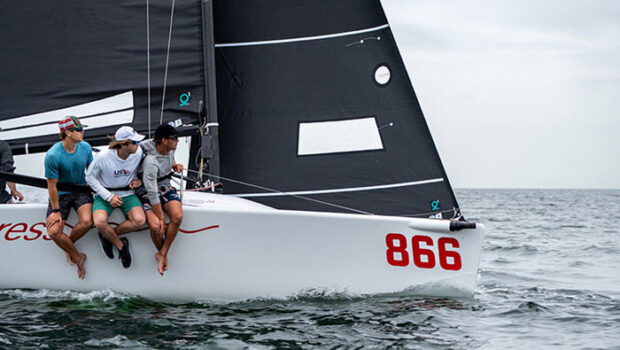Seven tips to launch your sailing season
Published on April 4th, 2023
From small one design dinghies to offshore keelboats, winter racing in Florida provides a break from cold weather but also a refresher course on racing. Following the Miami Bacardi events in March, Quantum Sails’ experts offer seven do’s and don’ts to launch your season:
Do Your Research
As soon as you receive Sailing Instructions, review course locations and make a plan for getting out to the course each day, advises Kris Werner, who sailed in the J/70 Class in Miami.
“Based on the forecast and course location, make sure to adjust your plans to give yourself enough time to get your tune-up in,” he says. “Ideally, arrive at the course area 45 minutes to an hour before the start.”
“On the water, know what to expect from the current, read the tide charts, and evaluate how these factors will impact your lay lines,” says George Szabo, who sailed in the Star Class in Miami.
Dave Gerber, who also sailed in the J/70, adds that before the start, take time to sail upwind on both tacks, making note of compass headings and getting a feel for the current. Also look for cloud movement. “Create an understanding of the first windward leg,” he says. “Getting to the first windward mark in a comfortable position is advantageous for the rest of the race.”
Don’t Skimp on Boat Prep
If you’ve prepared ahead, your first time out for the season will go more smoothly. Gerber suggests getting multiple colors of whipping twine from your local marine store and marking halyards in different colors, spots on your sheets for different time settings, marks on the tack line, pole line(s), topping lifts, and any other running rigging.
“At mark roundings and starts, boat traffic can get crowded, especially in the One-Design Classes,” he says. “Having excellent, repetitive marks allows you to make a quick and confident change.” Having a tuning guide on hand for all conditions is also a great tool to have for any regatta – create your own, or check out our one design resources.
Do Communicate
“During and after races and at the end of the day, make sure you debrief with the crew to clarify any situations you encountered so that you’ll see improvement at the next race,” says Werner.
Here’s how a conversation might go:
Trimmer: “The spinnaker was a little hard to get out to the end of the pole on that hoist.”
Tactician: “Yeah, I noticed the jib was eased too much and the clew was catching the spinnaker foot.”
Skipper: “Ok, let’s make sure to ease the jib less or maybe make a mark on the sheet for max ease during the hoist.”
Trimmer: “Sounds good!”
Next time, perfect hoist!
Don’t Miss the Lift
Keep your head out of the boat and eyes on the lifts as well as your competition or you risk missing a major tactical advantage. Eddie Cox, who sailed in the Melges 24 Class, says, “Sailing the lift longer than your competitor is always key. Taking transoms and tacking on the lee stern of your competitor is a high-risk move that rarely pays off.”
Do Adjust Your Setup
Along with doing your research on the conditions, it’s important to take a look at all condition factors when you get on the water and adjust your rig tune and sail setup accordingly. For example, when in chop, Szabo recommends less upper shroud tension to let the mast bend more sideways.
“In Miami, this, combined with a bit lower runner than usual, helped us bring power to the mainsail and sail faster overall in the Star,” he says.
Gerber adds, “As in any boat, wind force, wave state, air temperature, fleet size, current direction, and crew weight all contribute to your rig tune and sail setup. Make sure these variables are discussed with the whole team and a process is formed.”
Don’t Tack Below the Pressure
When it comes to pressure, one of two things will be true on course, says Cox. “You are either in it with a pressure and angle advantage or you are below it wondering why all the boats to windward are lifted. Make sure you are tacking as soon as you are headed and feel an increase in pressure. “If you aren’t tacking as soon as you are headed, you’ll be missing out on the next oscillation and won’t be able to connect to the next shift while in a clean lane.”
Do Watch the Weather
If the forecast calls for heavier wind and rain or might get dicey later in the day, prepare. Werner’s team made sure they had everything set up and ready to douse and store before the weather rolled in. “For example, in Miami we put up and dropped our mainsail inside the harbor and behind the shelter of land when possible,” he says. “It saved us from flogging the sail, but it also allowed for setup and cleanup to be done under calmer conditions where less can go wrong.”
For more resources and expertise, get in touch with your local loft.









 We’ll keep your information safe.
We’ll keep your information safe.